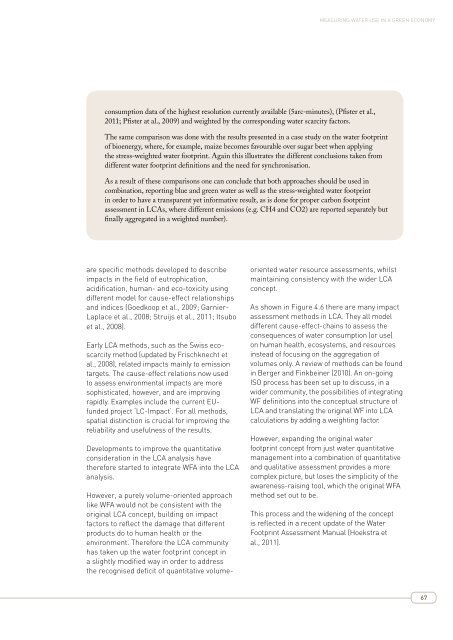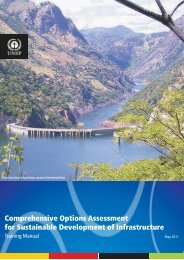MEASURING WATER USE IN A GREEN ECONOMY - UNEP
MEASURING WATER USE IN A GREEN ECONOMY - UNEP
MEASURING WATER USE IN A GREEN ECONOMY - UNEP
Create successful ePaper yourself
Turn your PDF publications into a flip-book with our unique Google optimized e-Paper software.
Measuring water use in a green economy<br />
consumption data of the highest resolution currently available (5arc-minutes), (Pfister et al.,<br />
2011; Pfister at al., 2009) and weighted by the corresponding water scarcity factors.<br />
The same comparison was done with the results presented in a case study on the water footprint<br />
of bioenergy, where, for example, maize becomes favourable over sugar beet when applying<br />
the stress-weighted water footprint. Again this illustrates the different conclusions taken from<br />
different water footprint definitions and the need for synchronisation.<br />
As a result of these comparisons one can conclude that both approaches should be used in<br />
combination, reporting blue and green water as well as the stress-weighted water footprint<br />
in order to have a transparent yet informative result, as is done for proper carbon footprint<br />
assessment in LCAs, where different emissions (e.g. CH4 and CO2) are reported separately but<br />
finally aggregated in a weighted number).<br />
are specific methods developed to describe<br />
impacts in the field of eutrophication,<br />
acidification, human- and eco-toxicity using<br />
different model for cause-effect relationships<br />
and indices (Goedkoop et al., 2009; Garnier-<br />
Laplace et al., 2008; Struijs et al., 2011; Itsubo<br />
et al., 2008).<br />
Early LCA methods, such as the Swiss ecoscarcity<br />
method (updated by Frischknecht et<br />
al., 2008), related impacts mainly to emission<br />
targets. The cause-effect relations now used<br />
to assess environmental impacts are more<br />
sophisticated, however, and are improving<br />
rapidly. Examples include the current EUfunded<br />
project ‘LC-Impact’. For all methods,<br />
spatial distinction is crucial for improving the<br />
reliability and usefulness of the results.<br />
Developments to improve the quantitative<br />
consideration in the LCA analysis have<br />
therefore started to integrate WFA into the LCA<br />
analysis.<br />
However, a purely volume-oriented approach<br />
like WFA would not be consistent with the<br />
original LCA concept, building on impact<br />
factors to reflect the damage that different<br />
products do to human health or the<br />
environment. Therefore the LCA community<br />
has taken up the water footprint concept in<br />
a slightly modified way in order to address<br />
the recognised deficit of quantitative volumeoriented<br />
water resource assessments, whilst<br />
maintaining consistency with the wider LCA<br />
concept.<br />
As shown in Figure 4.6 there are many impact<br />
assessment methods in LCA. They all model<br />
different cause-effect-chains to assess the<br />
consequences of water consumption (or use)<br />
on human health, ecosystems, and resources<br />
instead of focusing on the aggregation of<br />
volumes only. A review of methods can be found<br />
in Berger and Finkbeiner (2010). An on-going<br />
ISO process has been set up to discuss, in a<br />
wider community, the possibilities of integrating<br />
WF definitions into the conceptual structure of<br />
LCA and translating the original WF into LCA<br />
calculations by adding a weighting factor.<br />
However, expanding the original water<br />
footprint concept from just water quantitative<br />
management into a combination of quantitative<br />
and qualitative assessment provides a more<br />
complex picture, but loses the simplicity of the<br />
awareness-raising tool, which the original WFA<br />
method set out to be.<br />
This process and the widening of the concept<br />
is reflected in a recent update of the Water<br />
Footprint Assessment Manual (Hoekstra et<br />
al., 2011).<br />
67

















